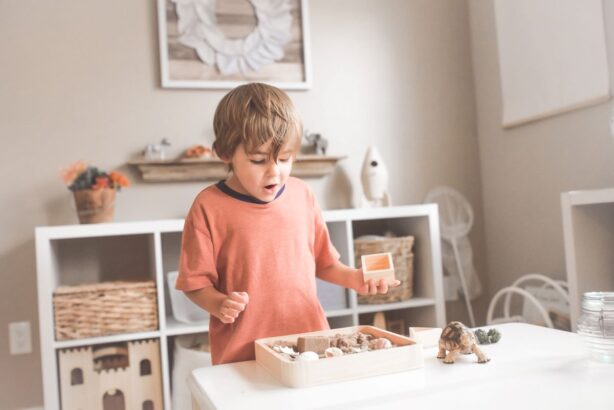Montessori shelves filled with hands-on materials are the foundation of Montessori learning environments.
These open-faced bookcases give children free access to engaging, meticulously-designed activities that promote concentration, coordination, and independence.

If you’d like to introduce these shelves into your child’s space, follow this guide on effectively using Montessori shelves to support your child’s natural development.
Understanding the Purpose of Montessori Shelves
A Thoughtful Design
Montessori shelves are a perfect example of the meticulous attention to detail that defines Montessori design.
Low-built wooden shelving places handcrafted materials at eye and hand height for children. This intentional placement signifies the child’s valued role in directing their learning.
Open shelving offers freedom of access, inviting children to fully examine intriguing items that capture their attention.
The shelves’ clean, uncluttered lines reflect core advanced principles. Limiting density spotlights each activity’s learning potential, providing children clarity in choosing meaningful activities.
Orderly left-to-right organization—progressing from simple to advanced, concrete to abstract—grants the child independence in managing increasingly complex concepts. Categorization links concepts across disciplines.
This coherence models the natural, fluid integration of knowledge. Sparseness and order grant children the mental spaciousness Montessori deemed vital for deep concentration, creativity, and developmental growth.
Though seemingly simple storage furniture, Montessori shelves and bookcases exemplify an educational philosophy that values a nurturing space where children enjoy an empowering education through purposeful work.
Planning Your Shelves
Designing Your Shelves
- Place low shelves, accessible to children, along the room’s perimeter to facilitate movement and activity
- Organize materials logically from left to right – simple to complex, concrete to abstract
- Limit to what will fit comfortably without clutter; rotate materials seasonally
- Arrange materials in order of size from largest on the bottom to smallest on the top
- Categorize by subject area with dividers, keeping related materials together
- Label bookcases so children can re-shelve properly to maintain order
Selecting Materials
- Choose age-appropriate, engaging, and diverse materials to cater to the child’s interests and developmental needs.
- Limit the number of items to avoid overwhelming the child and rotate them regularly to maintain interest.
Daily Integration of Montessori Shelves
Establishing Routines
- Integrating Montessori shelves into the daily life of a child provides structure and fosters independence and curiosity. Start by introducing the bookcases as a regular part of the day, perhaps after breakfast or before a nap. This consistent routine helps children anticipate and look forward to their learning time.
- Use visual or auditory cues to signal when it’s time to use the shelves. For instance, a special bell or a particular song can signify the start of ‘shelf time.’ This helps create a ritual around their learning, making it a cherished part of their day.
- Encourage children to engage with the shelves at their own pace. Some days they might be drawn to a particular activity for an extended period, while other days they might explore several different materials. This flexibility allows them to follow their interests and needs.
Guiding, Not Directing
- As children approach their Montessori shelves, offer gentle guidance on how to use the materials. Show them how to handle items with care and explain the purpose of each activity. However, once you’ve provided this initial guidance, step back and allow the child to lead their exploration and learning.
- Resist the urge to correct or direct their actions. The Montessori approach is about discovery and learning through trial and error. If a child is unconventionally using an item but is not at risk of harm or damaging the material, let their creativity flow. This encourages innovative thinking and problem-solving.
- Be a supportive presence. If a child seeks help or asks a question, be there to assist and guide them. Encourage them to try new things and gently nudge them towards more challenging activities when they seem ready. Your role is to facilitate learning, not control it, allowing them to develop confidence and autonomy.
Encouraging Interaction and Ownership
Fostering Independence
- Encourage children to take and return materials independently. This promotes responsibility and respect for their environment.
- Teach them how to handle materials carefully, explaining that this is their special learning space.
Creating a Learning Partnership
- Show interest in their activities without taking over. Ask open-ended questions like, “Tell me about what you’re doing?”
- Celebrate their achievements, no matter how small, to boost their confidence and motivation.
Choosing Materials Together
- Involve children in selecting and rotating materials. This gives them a sense of control and investment in their learning.
- Discuss why certain items might be interesting or beneficial, guiding them to make informed choices.
Overcoming Challenges
Dealing with Lack of Interest
- A child’s lack of interest can stem from various factors. Observe their behavior and environment to understand the root cause. It might be that the activities are too easy, too challenging, or simply not in line with their current interests or developmental stage.
- Engage with your child by demonstrating an activity yourself. Your involvement can pique their curiosity. Alternatively, refresh the shelf with new or rotated materials that cater to their evolving interests and needs. Sometimes, all a child needs is something novel to capture their attention.
- Remember, it’s crucial not to force engagement. Pressure can lead to negative associations with learning. Instead, offer choices and let them exercise autonomy in their selection. This approach often reignites a child’s natural curiosity and desire to explore.
Maintaining Order
- Consistently teach and reinforce the importance of tidiness. Discuss with your child how each item has its place and the benefits of returning materials after use. Explain that taking care of their environment is a way of showing respect for themselves and others.
- Incorporate tidying up as a regular part of their routine, perhaps at the end of each activity or before transitioning to a new task. This habit not only maintains order but also instills a sense of responsibility and care for their surroundings. Over time, children will begin to take pride in maintaining a clean and organized space.
Incorporating Montessori Principles Beyond the Shelves
Extending Learning
Apply Montessori principles to other areas of your child’s life. For example, allow them to assist with tasks like setting the table or watering plants.
This holistic approach reinforces the skills and values they learn from the bookcases.

A Journey of Discovery and Growth
Incorporating Montessori shelves into a child’s daily routine is a journey of discovery and growth, not just for the child but for parents as well.
It’s about creating a nurturing environment where children feel empowered to explore, learn, and develop at their own pace.
By following these tips and embracing the philosophy, you can foster a love for learning that lasts a lifetime.
